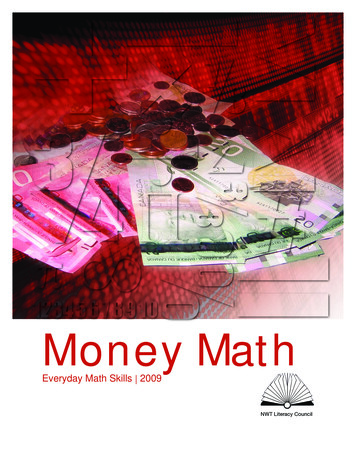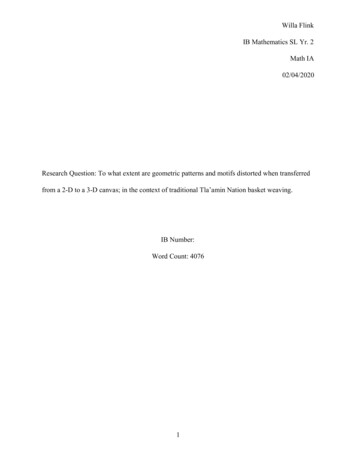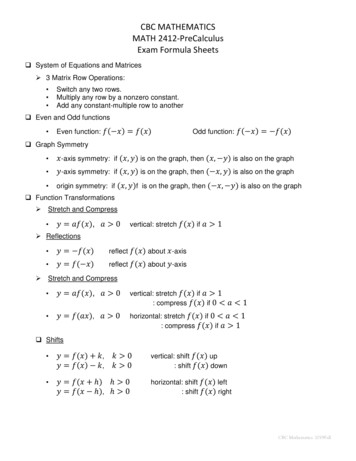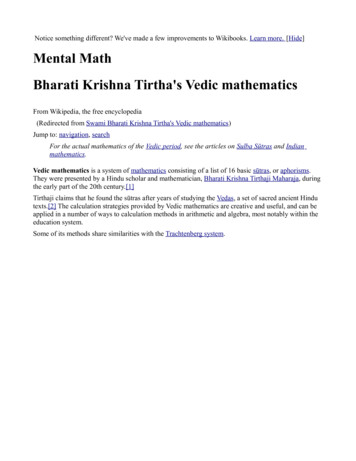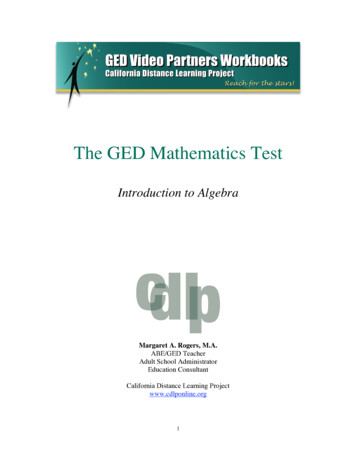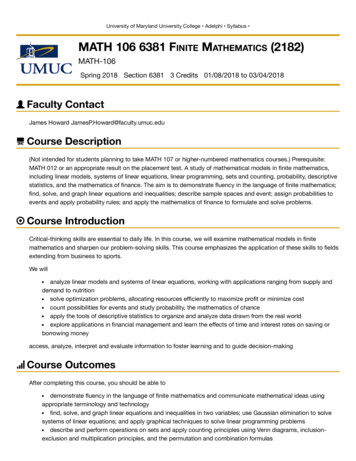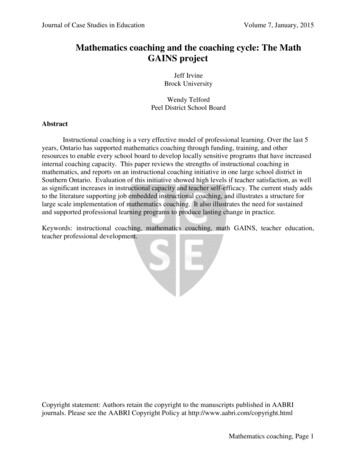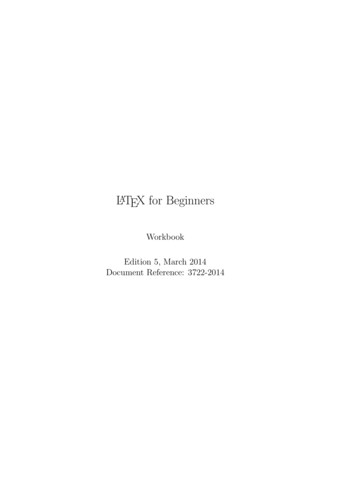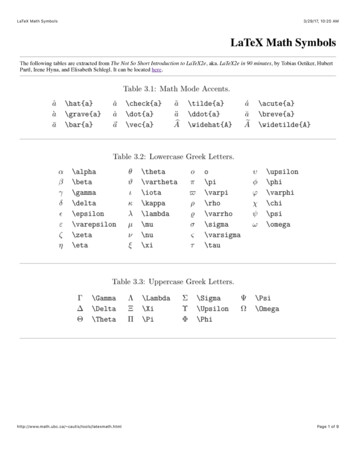
Transcription
LaTeX Math Symbols3/29/17, 10*20 AMLaTeX Math SymbolsThe following tables are extracted from The Not So Short Introduction to LaTeX2e, aka. LaTeX2e in 90 minutes, by Tobias Oetiker, HubertPartl, Irene Hyna, and Elisabeth Schlegl. It can be located here.http://www.math.ubc.ca/ cautis/tools/latexmath.htmlPage 1 of 9
LaTeX Math Symbolshttp://www.math.ubc.ca/ cautis/tools/latexmath.html3/29/17, 10*20 AMPage 2 of 9
LaTeX Math Symbolshttp://www.math.ubc.ca/ cautis/tools/latexmath.html3/29/17, 10*20 AMPage 3 of 9
LaTeX Math Symbolshttp://www.math.ubc.ca/ cautis/tools/latexmath.html3/29/17, 10*20 AMPage 4 of 9
LaTeX Math Symbolshttp://www.math.ubc.ca/ cautis/tools/latexmath.html3/29/17, 10*20 AMPage 5 of 9
LaTeX Math Symbolshttp://www.math.ubc.ca/ cautis/tools/latexmath.html3/29/17, 10*20 AMPage 6 of 9
LaTeX Math Symbolshttp://www.math.ubc.ca/ cautis/tools/latexmath.html3/29/17, 10*20 AMPage 7 of 9
LaTeX Math Symbolshttp://www.math.ubc.ca/ cautis/tools/latexmath.html3/29/17, 10*20 AMPage 8 of 9
LaTeX Math Symbols3/29/17, 10*20 AMLast modified: Wed May 31 14:04:55 CDT 2000http://www.math.ubc.ca/ cautis/tools/latexmath.htmlPage 9 of 9
XY-pic User’s GuideKristo er H. Rose hkrisrose@ens-lyon.fri Version 3.7, February 16, 19991 Basics1.1 Loading1.2 Entries .1.3 Arrows .1.4 Labels .1.5 Breaks .1.6 Curving1.7 SpeedingAbstractXY-pic is a package for typesetting graphs and diagramsusing Knuth’s TEX typesetting system. XY-pic works withmost of the many formats available; e.g., plain TEX,LATEX, and AMS-TEX. Several styles of input for variousdiagram types are supported; they all share a mnemonicnotation based on the logical composition of visual components. This guide concentrates on how to typeset“matrix-like” diagrams, such as commutative diagrams,in the following style:Ux(x,y)#yX Z Ypq Y/% Xfg /Zwas typeset by the XY-pic input lines\xymatrix{U \ar@/ /[ddr] y \ar@/ /[drr] x\ar@{. }[dr] -{(x,y)}& X \times Z Y \ar[d] q \ar[r] p& X \ar[d] f& Y \ar[r] g& Z\\\\}Such diagrams have the following characteristics: Specified as a matrix of entries that are automatically aligned in rows and columns. Any entry may be connected to any other entry using a variety of arrow styles all rotated andstretched as required. Arrows may be decorated with labels that are tiedto a specified point along the arrow and extend ina particular direction; and arrows may be paired,cross, and visit/bend around other entries “on theway.”Several other styles of input are supported; a short surveyof the possibilities is included last at the end along withinformation on how XY-pic can be obtained.ContentsPreface Laboratoire2.222233442 More Arrows and Labels2.1 Explicit label positioning2.2 Labeling with any object .2.3 More arrow styles . . . . .2.4 Sliding arrows sideways .2.5 More targets . . . . . . .2.6 Changing the target . . .2.7 Arrows passing under . .2.8 More bending arrows . . .2.9 Defining new arrow types.44556677883 More Entries3.1 Manual entry formatting . . . . .3.2 Extra entries outside the matrix3.3 Spacing and rotation . . . . . . .3.4 Entry style . . . . . . . . . . . .3.5 Naming for later use as targets .3.6 Grouping objects . . . . . . . . .99991010104 Availability and Further Information4.1 Getting XY-pic . . . . . . . . . . . . .4.2 Backwards compatibility . . . . . . .4.3 Further reading . . . . . . . . . . . .4.4 Credits . . . . . . . . . . . . . . . . .1111111213. . . . . . .up. . . . . . . . . . . . . . . . . . . . . . . . . . . . . . . . . . . . .typesettingA Answers to all exercises13References14Index15de l’Informatique du Parallélisme, Ecole Normale Supérieure de Lyon; 46, Allée d’Italie; F–69364 Lyon 7, France.1
Prefacewhere the “. . . ” should be replaced by entries to bealigned in rows and columns whereThis guide explains some features of XY-pic that arerelevant to typesetting of “matrix-like diagrams” asused in, for example, category theory; please refer tothe reference manual [8] for complete information onthe described constructions. The guide assumes thatyou have some experience in using TEX for typesetting mathematics, e.g., have studied [2, ch. 16–19], [3,sec. 3.3], or [9], and that XY-pic is installed on yourTEX system as described in the INSTALL file accompanying the distribution.The first section describes what you need to getstarted, in particular all that is needed to typesetthe diagram in the abstract. Section 2 and 3 explainadvanced use of arrows and entries, respectively. Finally, section 4 explains where and under what conditions XY-pic is available, gives the relation of version3.7 to previous versions, and lists further sources ofinformation.Throughout we give exercises that you should beable to solve as you go along; all exercises are answered at the end just prior to the references andindex.1 entries in a row are separated by &,4 and entire rows are separated by \\.For example,Awas typeset by i2cGGGGGGGGGDNotice the following: entries are typeset as mathematics (using “textstyle”); entries should not start with a macro(as illustrated by the use of {} around \bullet . all entries are centered and the separation between rows and columns is usually quite largein a diagram, empty entries at the end of rows may be omitted,This section explains the XY-diagram constructionconcepts needed to get started with typesettingmatrix-like diagrams. “XY-decorations” (here \ar[ul]) in entries allow drawing of arrows and such relative to theentries without changing the overall layout, and “XY-modifiers” (here * [F]) first in entries allow changing the format and shape in manyways.LoadingThe XY-pic setup used in this guide is loaded by inserting the lines1.3\input xy\xyoption{all}ArrowsAn “arrow” in an XY-pic diagram is a generic termfor the drawn decorations between the entries of thebasic matrix structure. In XY-pic all arrows must bespecified along with the entry in which they start; thisis called their base entry. Each particular arrow command then refers explicitly to its target entry. Thisis obtained using the \ar command which acceptsmany options of which we will describe a few hereand some more in section 2. In its simplest form anarrow is entered as \ar[hop] where hop is a sequenceof single letters: u for up, d for down, l for left, andr for right, e.g., the arrow \ar[ur] reads “typeset anarrow from the current entry to that one up and oneright.”in the definitions part of your document.1 If you wishto load only the features you use, or you wish to usenon-standard facilities like the v2 backwards compatibility mode2 or the ps PostScript3 backend thenthis is also possible as described in the reference manual [8].1.2i n\xymatrix{A &* [F]{\sum {i n} m {i 2}} \\& {\bullet} & D \ar[ul]}Basics1.1PmEntriesA diagram is created by the command\xymatrix{ . . . }1LATEX 2" [3] users can use \usepackage[all]{xy}.you use the version 2 loading command \input xypic (or the xypic document style option) then the v2 option described insection 4.2 will be loaded automatically.3 PostScript is a registered Trademark of Adobe, Inc. [1].4 Thus when using X -constructions involving & inside other tabular constructions then enclose the X -pic construction in an extraYYpair of braces!2 If2
Which entry does [] refer to?Exercise 1: \xymatrix@1{A\times B\times C\times D \ar[r] -{ } &B} The relative coordinates specified in this way arepurely logical, e.g., if the diagram contains very wideentries then “diagonal” arrows will be nearly horizontal. The constructed arrows are aligned along the linebetween the centers of the base and target entries;they will not automatically disappear under entriesthat they cross (we discuss how this is achieved insection 2.7).The arrow style kan be changed by writing thecommand as \ar@style[hop]. This will be describedin more detail in section 2.3; here we just list the mostcommon @styles (obvious variations also work):@{ }. @{. }@{: } @{ }VVV@{-- }. / B without the -).(it becomes A B C DIn fact - is in just one of the may possible placingsof labels described in section 2.1.Exercise 3:theory asf/BA@@@@@@ g;h@@g @@@@f ;g @@ C h /D@{-}. @{}.TypesetExercise 2:1.5 @@ @@@@@@@@@@@@o 1.4Typeset the second axiom of categoryBreaksIt is also possible to “break” an arrow with a label using the character: \xymatrix@1{A\ar[r] f&B} will set A f / B .If you just want an empty break you should/Buse the special \hole break: the arrow Awastypesetbyincluding \xymatrix@1{A\ar[r] \hole & B } in the text.A di erent use of breaks is to place a label somewhere in a diagram outside the normal matrix mesh:this is accomplished by “breaking” an invisible arrowobtained using the @{} arrow style: the squareLabelsYou can put labels on arrows. Labels are conceptualized as sub- and superscripts on arrows such that theyare placed in the usual positions (as “limits”), i.e., reads “above” and “below” on an arrow pointingright. Notice that the positions depend only on thedirection of the arrow, the absolute notions of “up,”“down,” etc. are not important. For example, \xymatrix@1{X\ar[r] a b & Y & Z\ar[l] A B } will set Xab/Y oBA/BA BZ (the @1 is a special code /Cwas typeset bythat can be used for “one-line” diagrams to improvethe placement on the line; more such spacing codesare described in section 3.3).It is possible to use labels that are not single letters, digits, or control sequences: if a simple mathformula in the default style (script style) is desiredthen simply enclose in {. . . }. In practice anythingcan be used as a label as described in section 2.2.Each label is placed perpendicular to the arrow atthe point halfway between the centers of the base andtarget objects. This is usually the most æsthethic,however, in diagrams where the sizes of the entriesvary much it is sometimes nicer to place the labelat the center of the actual arrow. This behaviour isrequested by inserting a - (minus) right after the / B was typeset byor : A B C D\xymatrix{\ar @{} [dr] { }A \ar[d] \ar[r] & B \ar[d] \\B \ar[r]& C}There is more on breaks in section 2.7.Exercise 4: Typeset the first axiom of categorytheory as the displayf/B gf iB B g /CA3
1.6matrix that can be loaded very quickly; they are automatically recreated when a matrix is changed.If this causes some diagrams to not work, thensuch compilation can be explicitly switched o byusing \xymatrixnocompile in place of \xymatrix.Compilation can be switched o completely with\NoCompileMatrices (which respects TEX groupingas does \CompileMatrices, by the way).And if you are still not satisfied with the speedthen you can add the following:CurvingArrows can be made to curve, for example to avoidgoing through another entry, using the special style@/curving/. The simplest styles of curving are thefollowing, shown applied to an arrow from A to B:)@/ /BA@/ /A5B@/ 1pc/A BAs the last example shows a dimension can be inserted just after or if more or less curving is desired.In case it is easier to specify the in- and out-goingdirections of the curving then that is also possible:use\OnlyOutlineswhich will omit all compiled pictures; the additionalcommand \ShowOutlines will add a dotted rectangleoutlining the size of the picture.@(in,out)2where in and out are one of the following directions:uOurul ? ONMLHIJK/rlo? ? drdl dIn this section we explain a number of variations ofthe arrow commands that are useful in commutativediagrams.2.1Typesetid1.79xkff1, will place the label at the point where theactual arrow begins, i.e., “appears from under”the base, so \xymatrix@1{A\ar[r] { }&B} /B .will typeset Af (x) Similarly, will place the label atthe point where the actual arrow ends,i.e.,“disappearsbelow”thetarget,so \xymatrix@1{A\ar[r] { }&B} will /B .typeset ASpeeding up typesettingOne thing that you will notice is that XY-pic is sometimes slow in typesetting diagrams (this is to be expected considering the number of drawing operationsperformed as reflected by the number last in eachxymatrix message). If you follow the rule of starting all entries with a (nonexpandable) character or {then you can insert the declaration and will place the following label at a point just a bit6 further fromthe beginning and end of the arrow,so \xymatrix@1{A\ar[r] { }&B} will / B . Using more s or s willtypeset A\CompileMatricesin the preamble of your document: this will createtemporary files5 containing compiled versions of eachmove the label further in.5 The6 “AExplicit label positioningThe label commands explained in section 1.4 placethe label text near the point along the arrow halfwaybetween the centers of the base and target entries.This, however, may be changed by inserting a placebetween the , , or , and the actual label (in fact is a place). In general you may insert the following:In this case the curving is computed such that thecurve begins at the base entry in the in directionand ends at the target entry from the out direction(this means that @(d1 ,d2 ) and @(d2 ,d1 ) are mirrorimages. See section 2.6 for more directions).Exercise 5:More Arrows and Labelstemporary files are named the same as your document but .tex is replaced by -n.xyc where n is a sequence number.bit” is in fact a TEX \jot which is usually 3pt.4
grow to enclosing squareshrinkshrink by dimenshrink to contained squaredo not centerroundadjust left, right,. . .frame double[F.] [F--]dotted dashed[F-,] [F-: 3pt ] shaded rounded A factor in ()s: (a) indicates that thelabel should be “tied” to the point a ofthe way from the center of the base entry (called (0)) to the center of the target (called (1)) instead of in the middle,so \xymatrix@1{A\ar[r] (.3){ }&B} will /B .typeset A - dimen - ![o][l] [r] [u] [d][F] [F ] A factor can be given after some or s, in which case the place is computedas if the base was specified by the sand target specified by the s.Hence \xymatrix@1{A\ar[r] (0){ }&B} will /B .typeset ASince objects specified this way start with no margin, a single is usually included to get the defaultspacing. Finally, there is a simple way to denote theplace on an arrow where it intersects with astraight line between two points: the place!{t1 ;t2 } places the label relative to the pointon the arrow where the line from the target t1to the target t2 crosses it. Bug: Only worksfor straight arrows at present.Exercise 7:@variant{tip}\txt{. . . }\composite{. . . *. . . }\frm{}Typeset/1 HHj4 1000000HHjjjj2000x HHH jjjjjjj x2j H#jjjj1000 2x / 2000Labeling with any objectXY-pic supports a general format for entering any TEXtext as labels (as well as entries to be explained later).The character * is reserved for this: in its simplestform *{math} will typeset the math material as anobject. This is like {math} except that the defaultstyle is ignored and there is no added blank margin.However, in general the following form of *objectis available:Exercise 8:2.3where modifiers can be used to change the shapeand size of the constructed object. The following arethe most common, the full list of possibilities can befound in the reference manual [8, fig. 3]:7 Thetip (or shaft) objectordinary textcombined objectsrepeat last objectHighlabelTypeset A B .More arrow stylesThe arrow styles described in section 1.3 are all examples of the general arrow style constructions*modifiers{text} dimen /B .(the possibilities for variant and tip are given in thefollowing section). Finally, \hbox{. . . }7 is a quickway to ensure text-mode interpretation of a single object. However, \txt allows the use of \\ in text to create a line break, and the special form \txt 6pc {. . . }will constrain the text to a centered 6pc wide column.By the way, \txt can be used outside of XY-pic constructions.Finally, several objects can be combined using thelast form; the *s serve to separate the composed object.1000000x2.2'&% !"#xThere can only be one boxing. This can be anybox generation command. The following are the mostuseful boxing{text} combinations:As usual more possibilities can be found in the reference manual [8, fig. 2].Exercise 6:Typeset A@variant{tail shaft head }@variant{head }that in describes arrows with the indicated tail, shaft,and head (on the first form the tail and head can beomitted; the second style defaults to having no tailand a standard shaft).growgrow by dimenplain TEX command \hbox corresponds to \mbox in LATEX and \text in the AMS variants.5
The following possibilities exist for head and tailwhich we will denote tips (here shown as heads):sss's's s% (/333'33 '3Ee )//x o'g{ -}Lg'''' {*}Exercise 9:jjjjjjjj4t4t 4t 4t - j jj j4t4t 4t2.4{ -}3{ -}{‘}{’}%E'g'g'g e)vTypeset A p0 v6 ?HN B . Sliding arrows sidewaysIt is often desirable to have several parallel arrowsbetween two objects. This can be done by sliding either or both arrows sideways a distance given as aTEX dimension enclosed in @ s: it specifies how far“sideways” the arrow should be moved, e.g.,.The variant should be empty or one of the following: 23'g'gThe even more general form *object can be used,where object refers to any of the constructions described in section 2.2.and the shaft should be one of the following:- { -}{ } {‘} {’}\xymatrix{A \ar@ 1ex [dr] a {.} \\& B \ar@ 1ex [ul] b \ar@ 1ex [r] c& C \ar@ 1ex [l] d {.} }“above” variant“below” variant“double” variant“triple” variantwill typesetHere are some standard arrows in this notation, allfrom A to B as usual:@{ - }Ao@ { - }Ao/B/B@ { - }Ao/B@2{ - }A ks 3 B@3{ - }jtA*4 BA @@@@ @@a@@. @@@ @b @@Boc./CdA positive distance will slide the arrow in the “ direction,” e.g., the two arrows above are slid in thedirection of the labels a, b, c, and d, respectively;a negative distance in the “ -direction.” The distance @1ex is often appropriate since it correspondsroughly to the height of letters like “x,” in the typesize being used.As a special convenience and : are provided as abbreviations for - and . with variant forced to 2.As it can be seen, the variant will a ect the entirearrow. Sometimes this is not what is wanted. In thatcase a local variant can be used by entering any ofthe tail, shaft, and head, on the following form:Exercise 10:variant{tip}variant{shaft}2.5Typeset A''B .More targetsThe target address can be given in a large number offormats called positions. The full range of possibilities is described in the reference manual [8, fig. 1];here is a number of useful ones in addition to the hopformat described in section 1.3:Here are some arrows where this is required: /B@{ {(}- }A/@{ - { }}ABNotice that there is no distinction between shafts andtips using this form, thus it is necessary to include allthree of tail, shaft, and head, when using it. The advantage is that it is possible then to “fill with a tip.”Furthermore, the following additional possibilities areavailable when using this notation: [r,c], where r, c are integers, denotes the relative entry found r rows below and c columns tothe right of the current entry (the current entryitself is thus [0,0]). This always correspondsto a [hop], e.g., [1,2] is the same as [drr]and [-2,0] is the same as [uu].6
/d dimen/ is the vector going dimen in the particular direction d which can be either the eightsimple ones in section 1.6, empty to denote thatthe current direction (the last direction of anarrow) should be used, or one of the following: "r,c", where r, c are positive integers, denotesthe absolute entry found in the rth row and cthcolumn of the diagram. The top left entry is"1,1". t0 ;t , where t0 is any target, changes the baseentry of the present arrow to t0 and then setsthe target to t relative to the original base entry. For example,va( )d:a( )d:(x,y)d / d\xymatrix{ A \\B & C \ar@ 1ex [ul]\ar@ 1ex [ul];[] }absolute anglerelative angle in degreesrelative
XY-pic User’s Guide Kristo er H. Rose hkrisrose@ens-lyon.fri Version 3.7, February 16, 1999 Abstract XY-pic is a package for typesetting graphs and diagrams




